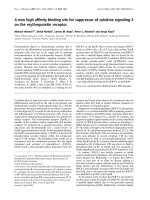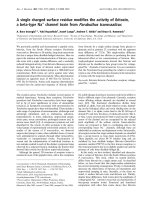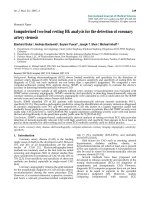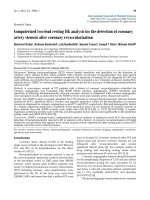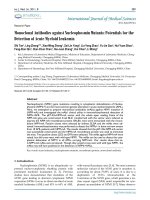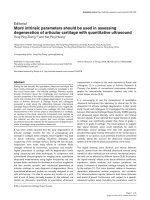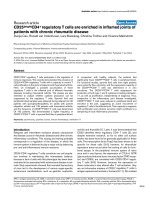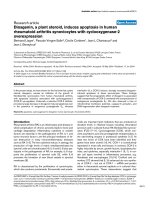Báo cáo y học: "Is smaller high enough? Another piece in the puzzle of stress, strain, size, and systems" pdf
Bạn đang xem bản rút gọn của tài liệu. Xem và tải ngay bản đầy đủ của tài liệu tại đây (42.07 KB, 2 trang )
Available online />Page 1 of 2
(page number not for citation purposes)
Abstract
Extracorporeal lung-supporting procedures open the possibility of
staying within widely accepted margins of ‘protective’ mechanical
ventilation (tidal volume of less than 6 mL per kg of predicted ideal
body weight and plateau pressure of less than 30 cm H
2
O) in most
any case of respiratory failure or even of further reducing ventilator
settings while still providing adequate gas exchange. There is
evidence that, at least in some patients, a further reduction in tidal
volumes might be beneficial. Extracorporeal procedures to support
the lungs have undergone tremendous technical developments,
thus reducing the procedure-related risks. However, what is true
for ventilator settings should also be true for extracorporeal
procedures: studies will have to demonstrate a convincing risk-
benefit ratio. In addition, a simple reduction of the tidal volume will
certainly not be the right answer. If extracorporeal support largely
influences gas exchange, the ‘optimal’ tidal volume/positive end-
expiratory pressure ratio keeping stress and strain low and
avoiding alveolar derecruitment will still have to be individually
defined.
In the previous issue of Critical Care, Zimmermann and
colleagues [1] published a prospective observational study in
which they applied a pumpless extracorporeal support
system to improve gas exchange in a series of 51 patients
still fulfilling acute respiratory distress syndrome (ARDS)
criteria after 24 hours of ‘advanced’ respiratory support
including low tidal volume ventilation (<6 mL/kg) as well as
positive end-expiratory pressure (PEEP) settings according to
the ARDSNet ‘high-PEEP’ table. Positioning was performed
either as prone positioning or as continuous lateral rotation
therapy (CLRT), balanced volume therapy, and infection
control [1,2]. The device consisted simply of two cannulas, a
short tubing system, and an oxygenator. Such a system uses
the individual cardiac output and resulting mean arterial blood
pressure in an arteriovenous setting as the driving force. The
principle is called pumpless ECMO (extra-corporeal mem-
brane oxygenation), spontaneous arteriovenous carbon
dioxide removal, or interventional lung assist, the last of which
represents the ‘official’ labeling of the company providing the
commercially available set used in this study. In brief, Zimmer-
mann and colleagues were able to demonstrate efficient
carbon dioxide removal at markedly reduced respiratory
settings after 2 hours and even more so after 24 hours. The
use of a well-defined algorithm including a restriction of the
cannula size used for arterial cannulation decreased the
number of ischemic complications when compared with two
preceding studies of the same group in which a consistent
rate of 10% ischemic complications was reported.
The study of Zimmermann and colleagues has evident
limitations: lack of a control group and/or randomization,
single-center performance, introduction and evaluation of
several interventions at the same time, and, in addition, lack of
clear definitions for terms like balanced volume therapy or
infection control. Even so, this does not narrow the impor-
tance of these findings. On the contrary, looking at these data
as a work in progress, we can draw several important
conclusions.
First, no matter what kind of extracorporeal lung support is
used, there is evidence that these procedures should repre-
sent well-defined steps in an escalating algorithm of acute
lung injury/ARDS treatment. As stress triggered by mecha-
nical ventilation is finally determined by the resulting trans-
pulmonary pressures transmitted by each breath (whereas
strain is related to the ratio between end-expiratory lung
volume and the applied tidal volume), smaller tidal volumes in
combination with an adequate level of PEEP (balancing the
ratio between tidal volume and end-expiratory lung volume)
should increase protectiveness of mechanical ventilation and
ideally reduce mortality [3-5]. Recent experimental work by
Dembinski and colleagues [6] demonstrated that a tidal
Commentary
Is smaller high enough? Another piece in the puzzle of stress,
strain, size, and systems
Michael Quintel and Onnen Moerer
Department of Anaesthesia and Intensive Care Medicine, University of Göttingen, Robert Koch Strasse 40, 37075 Göttingen, Germany
Corresponding author: Michael Quintel,
Published: 30 March 2009 Critical Care 2009, 13:126 (doi:10.1186/cc7738)
This article is online at />© 2009 BioMed Central Ltd
See related research by Zimmermann et al., />ARDS = acute respiratory distress syndrome; PEEP = positive end-expiratory pressure.
Critical Care Vol 13 No 2 Quintel and Moerer
Page 2 of 2
(page number not for citation purposes)
volume reduction at the same level of PEEP led to a marked
increase in shunt and low ventilation-perfusion (V
A
/Q) areas,
indicating sustained derecruitment of the lungs. This
phenomenon has also been demonstrated in the clinical
setting by Richard and colleagues [7] in ARDS patients while
reducing the tidal volume from 10 to 6 mL. The application of
lower tidal volumes obviously requires higher PEEP to avoid
alveolar derecruitment. In addition, in the context of
extracorporeal gas exchange, the weakness of the concept of
setting PEEP according to a table becomes evident, and in
the present study, what is very probably a ‘false’ PEEP
reduction (obviously triggered by the increase in the
PaO
2
/FiO
2
[arterial partial pressure of oxygen/fraction of
inspired oxygen] ratio after interventional lung assist insertion)
was induced after 2 hours and had to be corrected after
24 hours.
Second, cannula size matters when an arterial vascular
access is required. Even when the complication rate while
using cannula sizes of less than 17 Fr was reduced to 5.9%
in the present study, it still remains high, possibly too high
when this approach is used to achieve further ‘protective-
ness’ during mechanical ventilation [8,9]. There is some
evidence and personal experience that the restriction of
cannula sizes to 15 Fr or less minimizes the risk to a
negligible level. Ideally, however, one venous double-lumen
cannula would ensure the vascular access, and a small pump
that is very easy to handle may be integrated into the system
as a single-use product, delivering the flow in the range
needed in a given case. For evident reasons, the simple rule
‘the smaller, the better’ is not true. Smaller tidal volumes
require an individually adapted higher PEEP or continuous
positive airway pressure (CPAP) level and a lot of
experimental and clinical research to describe how an
optimized individual tidal volume/PEEP setting can be defined
while using a ‘safe’ extracorporeal lung support system that
enables gas exchange.
Competing interests
MQ is a member of the advisory board of Novalung GmbH
(Talheim, Germany) and therefore has received advisor
honoraria. OM declares that he has no competing interests.
References
1. Zimmermann M, Bein T, Arlt M, Philipp A, Rupprecht L, Mueller T,
Lubnow M, Graf BM, Schlitt HJ: Pumpless extracorporeal inter-
ventional lung assist in patients with acute respiratory dis-
tress syndrome: a prospective pilot study. Crit Care 2009, 13:
R10.
2. Brower RG, Lanken PN, MacIntyre N, Matthay MA, Morris A,
Ancukiewicz M, Schoenfeld D, Thompson BT; National Heart,
Lung, and Blood Institute ARDS Clinical Trials Network: Higher
versus lower positive end-expiratory pressures in patients
with the acute respiratory distress syndrome. N Engl J Med
2004, 351:327-336.
3. The Acute Respiratory Distress Syndrome Network: Ventilation
with lower tidal volumes as compared with traditional tidal
volumes for acute lung injury and the acute respiratory dis-
tress syndrome. N Engl J Med 2000, 342:1301-1308.
4. Terragni PP, Rosboch G, Tealdi A, Corno E, Menaldo E, Davini O,
Gandini G, Herrmann P, Mascia L, Quintel M, Slutsky AS, Gatti-
noni L, Ranieri VM: Tidal hyperinflation during low tidal volume
ventilation in acute respiratory distress syndrome. Am J
Respir Crit Care Med 2007, 175:160-166.
5. Grasso S, Stripoli T, De Michele M, Bruno F, Moschetta M,
Angelelli G, Munno I, Ruggiero V, Anaclerio R, Cafarelli A,
Driessen B, Fiore T: ARDSnet ventilatory protocol and alveolar
hyperinflation: role of positive end-expiratory pressure. Am J
Respir Crit Care Med 2007, 176:761-767.
6. Dembinski R, Hochhausen N, Terbeck S, Uhlig S, Dassow C,
Schneider M, Schachtrupp A, Henzler D, Rossaint R, Kuhlen R:
Pumpless extracorporeal lung assist for protective mechani-
cal ventilation in experimental lung injury. Crit Care Med 2007,
35:2359-2366.
7. Richard JC, Maggiore SM, Jonson B, Mancebo J, Lemaire F,
Brochard L: Influence of tidal volume on alveolar recruitment.
Respective role of PEEP and a recruitment maneuver. Am J
Respir Crit Care Med 2001, 163:1609-1613.
8. Bein T, Prasser C, Philipp A, Muller T, Weber F, Schlitt HJ,
Schmid FX, Taeger K, Birnbaum D: Pumpless extracorporeal
lung assist using arterio-venous shunt in severe ARDS. Expe-
rience with 30 cases. Anaesthesist 2004, 53:813-819.
9. Bein T, Weber F, Philipp A, Prasser C, Pfeifer M, Schmid FX, Butz
B, Birnbaum D, Taeger K, Schlitt HJ: A new pumpless extracor-
poreal interventional lung assist in critical hypoxemia/ hyper-
capnia. Crit Care Med 2006, 34:1372-1377.
